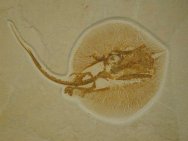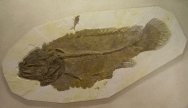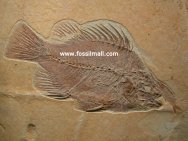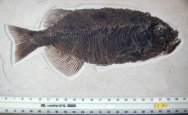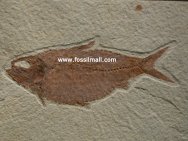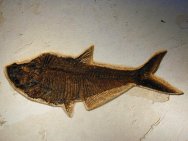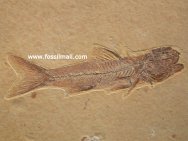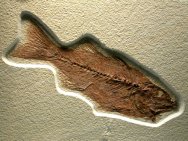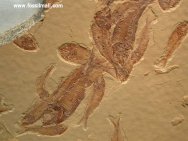Fish Fossils from Green River Formation
|
The Green River Formation in the United States is one of the world’s most famous Lagerstätte fossil sites. Its faunal assemblage contains fossils spanning the entire Tree of Life, across plants, invertebrates and vertebrates (including reptiles, mammals and even primates), and even Stromatolites. Despite the diversity, Green River is best known for its exquisite fish fossils. Class Actinopterygii, the ray-finned bony fishes, comprise almost half of all known species of vertebrates, some 20,000 extant species. There are numerous locations worldwide that are noted for wondrous preservation of bony fishes, and the Green River formation that covers some 25,000 square miles of southwest Wyoming, western Colorado and eastern Utah is one of them. The formation is one of the largest lacustrine (i.e., lake) sedimentary accumulations in the world, with an average thickness of some 2000 feet. The vast deposits were laid down between about 48 and 54 million years ago, during the Eocene Epoch of the Cenozoic Era. The Green River Formation is actually a heterogeneous complex of lakes that differed in their ecological and geological characteristics, geological timeframes and thus fauna and flora of their time. The complex comprises three primary lakes formed as a consequence of drainage from tectonic highlands involved in the uplift of the Rocky Mountains from the late Cretaceous through the Paleocene periods some 80 to 55 million years ago. Fossil lake, centered in Southwest Wyoming, is the smallest and appeared briefly during the early Eocene. The Lake Gosiute deposits span the period from Lower to Middle Eocene, and the largest deposit from Lake Uinta that ranges across the Utah-Colorado border, spans most of the Eocene Epoch. During the Eocene, based on the fossil record, the region was sub-tropical to temperate. Some 60 vertebrate taxa have been described from the formation, as well as abundant invertebrates and plants. Green river has been noted for its well-preserved fish since mid-way through the 19th century. The unusually excellent preservation of the Green River fish fossils is usually attributed to a combination of two factors: 1) a cold period during the Eocene that would have caused dead fish to sink faster due to a less inflated swim bladder; and 2) the great depth of the lakes and the consequent anoxic conditions that would have often prevented scavengers from disturbing the carcasses. The majority of fish fossils are taken from the Fossil Lake area from two layers: 1) the so-called 18-inch layer; and 2) the spilt fish layer. The best preserved fish come from the 18-inch layer. Because the sediment is highly laminated, the fish can often be removed nearly whole. This layer, in the area near Fossil Butte, does indeed average about 18 inches in thickness, corresponding to about some 4000 years of sedimentary deposition. The composition of the limestone indicates that the layer was formed in deep water far from shore. By contrast, the so-called split-fish layer is not laminated, making removal and preparation of the best fish fossils more difficult. The layer is about six feet thick, and the fauna indicates water that was better circulated than that associated with the 18-inch layer. Some 19 genera of Eocene fish come from the Green River formation as shown in the table below.. Green River Formation Fossil Fish
|

